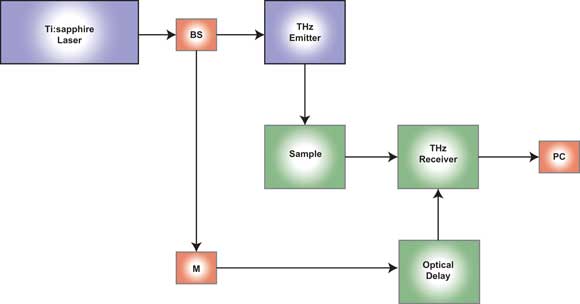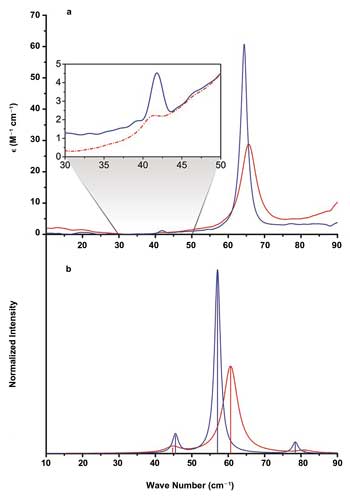Advances in terahertz imaging and spectroscopy are making it easier for pharmaceutical researchers and manufacturers to predict crystal structures of common and uncommon drugs as well as to distinguish among drug polymorphs.
For a little more than a decade, the pharmaceuticals industry has gradually adopted terahertz-based technology – especially as more manufacturers enter the field and offer their own improvements – but there remains a lack of clear understanding about the interactions between terahertz radiation and the organic molecules that comprise active pharmaceutical ingredients.
Spectroscopy and imaging in the terahertz frequency range (100 GHz to 10 THz, equivalent to 30 to 3000 µm, or 3 to 333 cm—1, depending on which units you prefer) are very handy for analyzing pills, tablets and other pharmaceutical products. Scanning active and inactive ingredients alike, such as aspirin pills and their coatings, speeds quality control on the production line, but the technique also is good for developing a deep understanding of the crystalline nature of most drugs and druglike compounds early in the drug discovery phase.

A schematic of a basic terahertz spectroscopy system. BS = beamsplitter; M = mirror.
Terahertz radiation is well able to characterize crystalline materials because it probes the lattice features integral to a solid crystal’s shape, and thus function. Terahertz-based techniques are a fairly recent development, but have taken hold in the pharmaceutical field because they can be used for nondestructive, real-time analysis of products.
A femtosecond Ti:sapphire laser is the instrument of choice for generating the energetic photons needed to drive a terahertz radiation source. Each pulse generates electron-hole pairs in a carefully designed photoconductive semiconductor material formed as radiation-emitting antennas that release short, coherent bursts of terahertz energy when an electric field is applied while the Ti:sapphire laser is pumping.
Terahertz imaging and spectroscopy typically are used to quantify and analyze polymorphs of drug compounds as well as to characterize tablet coatings and their dissolution properties and to map the distribution of active and inactive ingredients within a tablet.
Polymorphisms are a chief concern in modern pharmacology. Even with the same basic chemical structure, a drug compound may exhibit slightly different crystalline structures – think diamond vs. graphite, both polymorphs of carbon. These variations, to the initial surprise of many, may have a profound effect on a drug’s absorption, distribution, metabolism and excretion once it enters a patient’s body. For example, the dissolution rate of a drug can be profoundly affected by its crystalline form, and qualities such as stability, hardness, coloring, solubility and bioavailability can be affected.

(a) Researchers checked the terahertz spectra of creatine at room temperature (293 K; red) and at 78 K (blue). (b) Simulated terahertz spectra reproduced how vibrational frequency changes occurred in response to changes in the crystal structure. Courtesy of Crystal Growth & Design.
Importantly, polymorphisms carry a financial significance in that drug patents may apply to only a single form of the crystal, which must have specifically stated main and side effects.
Determining polymorphs of a drug compound traditionally has been accomplished using x-ray crystallography, but this technique is slow, cumbersome and potentially dangerous to technicians, and thus cannot be used effectively on a processing line in a manufacturing plant.
The acid test
Almost every pharmaceutically interesting compound exhibits polymorphism. Because of this, it has become very important to further the overall understanding of how detectable changes occur in the vibrational status of a crystal’s lattice structure.
In the department of chemistry at Syracuse University in New York, Timothy M. Korter and his colleagues are seeking a better way to rapidly detect unwanted polymorphisms of various drug compounds.
Terahertz spectra can provide a lot of information regarding the lattice structure of crystals, which readily identifies various polymorphs of a drug molecule, but Korter’s group was concerned with how best to interpret the data. The researchers turned to solid-state density functional theory (DFT), a computational method known for its ability to reproduce crystalline structures with unrivaled accuracy.
Exploiting the ability of terahertz spectroscopy and solid-state DFT to discern the intramolecular interactions in crystals, the group recently explored the spectra of diclofenac acid, a member of the class of drugs known as NSAIDs (nonsteroidal anti-inflammatory drugs), used to treat muscle aches and arthritis. They probed two known polymorphs of the compound, finding that the terahertz spectra revealed distinct differences between the two forms in their crystal packing arrangements and internal molecular interactions. Their work is described in the April 11, 2011, issue of Analytical Chemistry.

Analysis of the terahertz spectra from a sample of diclofenac acid can readily distinguish between the two chief forms, or polymorphs, of the drug. Courtesy of Analytical Chemistry.
As with many other drugs, when diclofenac acid is formed, two or more polymorphs often are created at the same time and become mixed in the batch. Because of the disparate effects each polymorph may have, the various types must be separated, or the entire batch discarded – not good for business. The Syracuse researchers showed that the terahertz spectra easily distinguished the two polymorphs in a mixture by determining their relative abundances.
Later on, working with colleagues from Eastman Kodak Co. of Rochester, N.Y., and from Alfred University, also in New York, Korter directed the terahertz spectroscopy/solid-state DFT technique at the problem of predicting the crystal structure of previously unclarified pharmaceutical chemicals.
In a paper published in the Nov. 16, 2011, issue of Crystal Growth & Design, Korter and his colleagues noted that the basic crystalline structure of the amino acid creatine has not yet been delineated, even by traditional techniques such as x-ray crystallography. Creatine is vastly important to human biology, as it supplies energy to cells by increasing the availability of adenosine triphosphate.
The terahertz spectroscopy setup used by Korter’s group comprises a diode-pumped solid-state Nd:YVO4 laser made by Coherent Inc. that pumps a Coherent Ti:sapphire oscillator. The 800-nm output of this system was fed into a Ti:sapphire regenerative amplifier made by Positive Light of Los Gatos, Calif. (now part of Coherent). The amplifier was concurrently pumped by an Nd:YLF laser, also made by Positive Light. The resulting beam emitted by the amplifier entered a zinc telluride crystal, which then generated terahertz pulses.
The investigators used solid-state DFT to predict the structure of creatine, then the terahertz spectroscopy setup and powder x-ray diffraction data to confirm the validity of the predicted model. DFT works for this task, they say, because it locates the minimum-energy configurations of the lattice structures within the crystal with high sensitivity.
More than meets the eye
Besides straight-up variations in the crystalline structure of the same chemical compound, solvation and hydration variations can sometimes occur, resulting in structures called pseudopolymorphs. To test how well terahertz spectroscopy differentiates between forms including pseudopolymorphs, researchers at Daiichi Sankyo Ltd. in Kanagawa and at Toho University in Chiba, both in Japan, examined the drug compound theophylline.
Originally derived from tea leaves, but now often synthesized, theophylline is commonly used as a bronchodilator for chronic obstructive pulmonary disease and similar afflictions. The compound was a useful target for the researchers because it has known monohydrated (including a single molecule of water) and anhydrous (no water at all) forms. The researchers, who reported their work in the April 2011 issue of Chemical & Pharmaceutical Bulletin, wanted to develop a method that could be used to determine the relative amounts of monohydrated and anhydrous forms of the molecule in a single tablet containing both theophylline and other substances, such as cellulose and magnesium stearate.
The investigators used a terahertz time-domain spectrometer made by Tochigi Nikon Corp. of Japan, which scans samples in the 0.2- to 2-THz range with a resolution of 0.04 THz. They found that the anhydrous form exhibits an absorption peak at 0.96 THz, which decreased in intensity with a like drop in the proportion of that polymorph compared with the other materials. They found no such peak associated with the monohydrated theophylline.
The group further showed that terahertz spectroscopy could be used to predict the dissolution rate of the theophylline tablets, based on their precise composition.